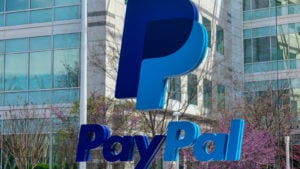3 Disruptive Fintech Stocks to Buy That Can Make You a Millionaire
Finding the best fintech stocks to buy can be a challenge. After all, they didn’t do very well in 2022. These stocks underperformed compared to S&P 500 after a couple of healthy years.
Due to persistent macroeconomic headwinds, they are not doing well. However, investing in finance is full of daily adventures, making it unwise to overlook undervalued fintech stocks to buy. These choices have the potential to massively disrupt the market.
The fintech industry presents an interesting investment opportunity, as the pandemic has accelerated the trend towards digital payments.
The increase in work-from-home arrangements, shutdowns and e-commerce has increased the demand for digital payment solutions, providing significant benefits for many fintech firms.
As a result, fintech stocks are becoming increasingly popular. They provide the opportunity for unexpected profits and significant growth over time. This trend has highlighted the success of this sector, making it a desirable choice for investors.
While pandemic-induced tailwinds are diminishing and macro challenges, geopolitical concerns and a potential economic slowdown could affect fintech stocks in the short term, the long-term outlook for the fintech space remains promising.
The continued rise of e-commerce, the growing use of contactless and mobile payments, and the convenience and speed of transactions contribute to an attractive long-term outlook for the fintech industry.
Therefore, don’t let the recent banking crisis deter you from investing in fintech.
With the long-term outlook in mind, we’ve put together a list of three fintech stocks to buy.
| PYPL | PayPal Holdings | $73.24 |
| MELI | MercadoLibre | $1214.96 |
| BAC | Bank of America | $28.75 |
PayPal (PYPL)

PayPal Holdings (NASDAQ:PYPL) has established itself as the leading player in the online payment industry, supported by a remarkable portfolio of businesses.
The Venmo platform for person-to-person payments has positioned itself as the industry’s top performer and continues to experience impressive growth in its user base.
PayPal has also made strategic acquisitions of complementary businesses, including Honey’s e-commerce tools, which serve it well.
In 2022, PayPal faced challenges in its merchant market as several unprofitable and emerging fintech stocks faced a significant decline.
Despite not fitting this description, the company’s revenue decline and growth concerns resulted in it being treated in the same way as recent unprofitable fintech startups, leading to a significant decline in its share value from previous peaks.
PayPal experienced a sluggish 8% growth in revenue, marking its weakest performance in years. The company’s non-GAAP (adjusted) earnings per share saw a 10.2% year-over-year decline, resulting in a figure of $4.13.
This underperformance can be attributed to the long-awaited full split with eBay (NASDAQ:EBAY), which stopped using PayPal to pay merchants the previous summer. But excluding eBay, PayPal’s revenue rose a more impressive 12%.
Adding to these struggles are the company’s weak operating vitals, with user growth of just 2% in 2022 and total payment volume (TPV) growing just 9%.
While not catastrophic, these numbers represent a decline from previous results, and Wall Street has reacted accordingly. Over the past five years, PayPal’s TPV growth has averaged 24%, or 28% if you exclude eBay. Between 2019 and 2021, active accounts rose from 305 million to 426 million.
Therefore, the recent share price decline seems excessive. PayPal’s current valuation suggests it represents a compelling value opportunity.
MercadoLibre (MELI)

Source: rafapress / Shutterstock.com
MercadoLibre (NASDAQ:MELI) is a leading online marketplace for Latin America.
This platform offers various products and services, everything from clothes to electronics. Because of its business model, investors often refer to MercadoLibre as Amazon (NASDAQ:AMZN) in Latin America.
Execution is the primary reason to invest in the company. The company exceeded consensus estimates for revenue and earnings in the fourth quarter. The figures were surprising as we are in a difficult operating environment.
Unlike many struggling e-commerce players, MercadoLibre achieved solid year-over-year growth in gross merchandise volume across its three main markets in Q4, with growth rates of 83% in Argentina, 22% in Brazil and 28% in Mexico .
This impressive performance is due to the company’s well-established logistics network, which boasts a remarkable 94% penetration rate in the Latin American market, providing a significant competitive advantage. Despite the high level of network and fulfillment center penetration, the company maintained control over shipping costs.
MercadoLibre has harnessed the power of its e-commerce business to establish a formidable fintech ecosystem. Originally introduced in 2003 to facilitate e-commerce transactions, Mercado Pago has become a complete financial services company. And its focus on the Latin American market gives it a competitive advantage over its peers.
In addition, Mercado Credito, the company’s credit arm, enables loans to suppliers and customers, increasing enthusiasm for the electronic marketplace from all parties involved. This cohesive effect is why Mercado Libros thrives.
Despite the significant size and robustness of its business model, the stock currently trades at a tempting value of just 5.6 times price-to-sales. That makes it one of the more attractively valued fintech stocks to buy.
Bank of America (BAC)

Source: Michael Vi / Shutterstock.com
If you’re looking for solace when more banks implode, then Bank of America (SNEEZE:BAC) is one of the safer fintech stocks to buy. The last few weeks show that the banking sector is far from boring.
Bank of America’s recent awards have demonstrated its commitment to technology. That includes being named the top bank for “Online Banking and Mobile Banking Functionality” by Javelin and receiving the “Best Digital Consumer Bank in the US” award from Global Finance in 2022.
These awards underline the critical role technology has played in the bank’s growth and development.
Like other banks, Bank of America profited from the Federal Reserve’s hawkish rate hikes in 2022.
While inflation has slowed, it has yet to reach the 2% target set by the Fed. It suggests that further rate hikes are likely to occur in 2023 and beyond, albeit less aggressively. This development will boost Bank of America in the coming quarters.
Investors seeking long-term growth and income potential will consider BAC at this critical time. A robust balance sheet, favorable positioning within the current economic situation and an attractive dividend yield of 3.06% represent an attractive investment option for those looking for fintech stocks to buy.
Let the current crisis be an opportunity. Shelby MC Davis, a legendary money manager, sums it up well. “Invest for the long term. Don’t get too greedy, and don’t get too scared.”
At the date of publication, Faizan Farooque did not hold (directly or indirectly) any positions in the securities mentioned in this article. The opinions expressed in this article are those of the author, subject to the InvestorPlace.com Publishing Guidelines.


